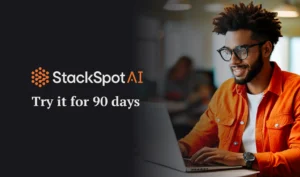Note: This blog post was created by the StackSpot Prompt Engineering team with the support of AI tools. This content underwent rigorous review for technical accuracy, content relevance, and well-written quality before its publication. Enjoy the read!
As a senior software engineer, you understand the challenges and complexities of working on large-scale operations. Legacy systems, often characterized by outdated technology and inefficient processes, can hinder progress and impede innovation. In this blog post, we will explore the importance of championing legacy modernization and provide expert advice on successfully navigating this transformation.
The Significance of Legacy Modernization in Large-scale Operations
Legacy systems have long been the backbone of many large-scale operations. They have served their purpose faithfully over the years, but as technology advances, they can become a roadblock to progress. Legacy modernization refers to updating and transforming these outdated systems to meet the demands of today’s fast-paced and ever-evolving digital landscape.
Embracing Change: The Key to Success
Change is inevitable, and in software engineering, it is essential for growth and innovation. Senior software engineers must champion legacy modernization to ensure the continued success of large-scale operations. By embracing change and advocating for the modernization of legacy systems, engineers can drive efficiency, scalability, and overall business success.
3 Challenges of Legacy Modernization
Legacy modernization has its challenges. From budget constraints to stakeholder resistance, there are various obstacles that senior software engineers may encounter along the way.
However, it is crucial to approach these challenges with a critical perspective and find innovative solutions that address both technical and business requirements.
1 – Balancing Technical Debt and Business Priorities
One of the main challenges in legacy modernization is striking the right balance between addressing technical debt and meeting immediate business priorities. While it may be tempting to focus solely on technical improvements, it is essential to align modernization efforts with the organization’s strategic goals. This requires a deep understanding of the technical aspects and the business implications of legacy modernization.
2 – Building a Strong Business Case
To gain support for legacy modernization initiatives, senior software engineers must build a strong business case that highlights the benefits and return on investment. This involves quantifying the potential cost savings, improved efficiency, and reduced risks associated with modernizing legacy systems. By effectively communicating the value proposition to stakeholders, engineers can secure the necessary resources and support for successful modernization.
3 – Collaborating Across Teams and Departments
Legacy modernization is a complex undertaking that requires collaboration across teams and departments. Senior software engineers must foster a culture of collaboration and create cross-functional teams that bring together expertise from various areas. By breaking down silos and encouraging open communication, engineers can overcome barriers and ensure a smooth transition during the modernization process.
4 Best Practices for Successful Legacy Modernization
Legacy modernization can be a daunting task, but with the right approach, it can lead to significant improvements in efficiency and scalability. Here are some best practices for senior software engineers to consider when championing legacy modernization in large-scale operations:
1 – Conduct a Comprehensive Assessment
Before embarking on a legacy modernization journey, it is essential to conduct a comprehensive assessment of the existing systems. This includes evaluating the current state, identifying pain points, and understanding the desired future state. By gaining a clear understanding of the system’s strengths and weaknesses, engineers can develop a well-informed modernization strategy.
2- Prioritize Incremental Modernization
Instead of attempting a complete overhaul of the legacy system, it is often more practical and less disruptive to prioritize incremental modernization. Breaking down the modernization process into smaller, manageable phases allows for iterative improvements and reduces the risk of system-wide failures. This approach also enables teams to learn from each step and make necessary adjustments along the way.
3 – Leverage Automation and DevOps Practices
Automation and DevOps practices play a crucial role in legacy modernization. By implementing automated testing, continuous integration, and deployment pipelines, engineers can streamline the modernization process and ensure faster, more reliable deployments. These practices also promote collaboration and transparency across teams, enabling a smoother transition to the modernized system.
4 – Invest in Continuous Learning and Skill Development
Legacy modernization requires a diverse skill set and a deep understanding of legacy systems and modern technologies. Senior software engineers should invest in continuous learning and skill development to stay up-to-date with the latest trends and best practices. This includes attending relevant conferences, participating in online courses, and actively seeking opportunities to expand their technical knowledge.
Championing Legacy Modernization: Embrace the Future
Legacy modernization is not just a technical endeavor; it is a strategic move that can significantly impact the success and growth of large-scale operations. As a senior software engineer, it is your responsibility to champion this transformation and drive the necessary changes. By approaching legacy modernization with a critical perspective, leveraging best practices, and fostering collaboration, you can ensure a successful transition to a more efficient and scalable system.
Unlock the power of Legacy Modernization with StackSpot!
Are you navigating the intricate maze of legacy modernization? Discover how StackSpot helps with this process.
Seamlessly integrate new-age technologies, benefit from tailored automation, and leverage AI-driven insights to transform your legacy systems. Don’t just modernize… revolutionize!
Dive into StackSpot now and be the catalyst for your company’s digital metamorphosis. Explore StackSpot today!






